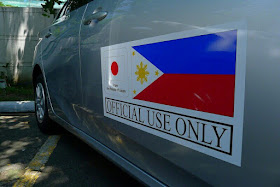The Japanese government, through its Non-Project Grant Aid, has funded the purchase of P250-Million worth of Toyota Prius Hybrid cars. They did this to support the Philippine Government, specifically the Department of Energy's campaign to promote energy efficiency and clean air across the country. The DOE will distribute the cars to replace some service vehicles of national government offices with hybrid cars.
Officials of the Energy Utilization Management Bureau and Japan’s Ambassador to the Philippines, Kazuhide Ishikawa, turned over the hybrid Toyotas to the beneficiaries last Friday at the DOE Sunken Garden in Taguig.
The Non-Project Grant Aid (NPGA) is part of the Japan International Cooperation System.
A hybrid car is called such because it is powered two different ways. It has an optimized fuel engine while also having an electric motor to provide another means of moving the vehicle. Using a computer, the car can move by either mechanism or both at the same time, depending on the driving conditions. The electric motor is usually for slow speed. The fuel engine comes in when more power is needed. Also, when the car is on a downhill road, or when the car is cruising, the batteries are actually being charged by the electric motor. This increases the efficiency of the car. In uphill climbs, the motor assists the fuel engine so that less fuel is also used. This is how hybrid vehicles attain the highest energy efficiency. The best part is that hybrid cars have lower carbon emission, making it more environmentally friendly.
The beneficiaries of the hybrid cars include the Office of the President, Department of the Interior and Local Government (DILG), Department of Finance (DOF), Department of Foreign Affairs (DFA), Department of Budget and Management (DBM), Department of Transportation, Department of Tourism (DOT), Department of Trade and Industries (DTI), Department of Environment and Natural Resources (DENR), National Economic Development Authority, Department of Science and Technology (DOST) and the Philippine National Police.
Eight hybrid cars will also be given to government offices in Region 8, including the DENR, DTI, DOST, Bureau of Fire Protection, Philippine Information Agency, Land Transportation Office and the Regional Disaster Risk Reduction and Management Council. They were given priority to support the recovery of the local government and the many communities devastated by Super Typhoon Yolanda in 2013.
“This Japan government-aided grant will jump-start our drive towards our call to action to our fellow public servants to increase their use or patronize energy efficient technologies, including their official vehicles. We have to be the role model in this cause, so our people can look up to us and follow our lead,” Energy Secretary Alfonso Cusi said.
In the Philippines, a compact version of Prius is available, the Prius C. Toyota Philippines website quotes the price of the standard model at P1,639,000. The full options sells for P1,689,000.
Eight hybrid cars will also be given to government offices in Region 8, including the DENR, DTI, DOST, Bureau of Fire Protection, Philippine Information Agency, Land Transportation Office and the Regional Disaster Risk Reduction and Management Council. They were given priority to support the recovery of the local government and the many communities devastated by Super Typhoon Yolanda in 2013.
“This Japan government-aided grant will jump-start our drive towards our call to action to our fellow public servants to increase their use or patronize energy efficient technologies, including their official vehicles. We have to be the role model in this cause, so our people can look up to us and follow our lead,” Energy Secretary Alfonso Cusi said.
In the Philippines, a compact version of Prius is available, the Prius C. Toyota Philippines website quotes the price of the standard model at P1,639,000. The full options sells for P1,689,000.
source: PhilStar
©2017 THOUGHTSKOTO
SEARCH JBSOLIS, TYPE KEYWORDS and TITLE OF ARTICLE at the box below








No comments:
Post a Comment